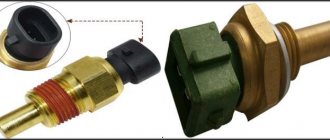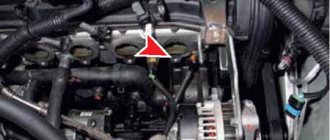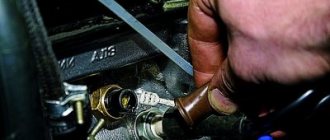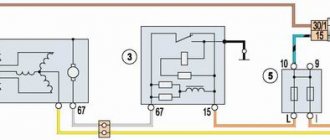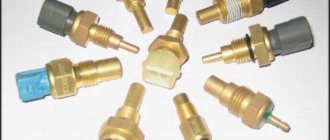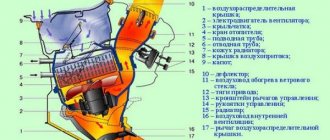For the cooling system of any car, including the popular Lada Priora, it is not the most pleasant moment to be stuck in a traffic jam for a long time. When the car moves without long periods of downtime, the temperature load is removed by the oncoming air flow. There is no such flow when idling. When overheating, the radiator fan automatically turns on, but only if the coolant temperature sensor is working properly. This is a very necessary functional device for a car. If the sensor does not work, replacement is required. In this material we will analyze in detail how the device works and where it is located. No less useful will be information on how to change this sensor on a Lada Priora. To replace, you will need a certain set of tools; such a tool is not a problem for a hundred; it is available in any car service center.
Temperature sensor Lada Priora
The coolant temperature sensor (abbreviated DTOZH) in Priora is a thermistor.
In other words, this is a resistor whose resistance will vary with temperature. Motorists know that if this sensor breaks down in the summer, the car can boil. To prevent such a situation, which could lead to more serious damage, it is important to know where the temperature sensor is located. And, most importantly, how to recognize the symptoms of its breakdown.
Diagnostics
To check the DTOZH in a garage or at home, you will need a container with coolant. You also need a thermometer that can accurately measure temperature up to 120 degrees.
It is necessary to replace the sensor resistance in different temperature conditions. Antifreeze must be heated during the diagnostic process. The data obtained on the multimeter is compared with the temperature on the thermometer.
So, at 100 degrees the sensor resistance will be approximately 178 Ohms. At 90 degrees - 239 Ohms, at 82 - 319 Ohms. At zero it will be about 7278 ohms.
Location and characteristics
On the Priora, the sensor is located on the cylinder head on the right side near the thermostat (it is located above the flywheel housing in the engine block). Its connection is made directly to the engine control unit. It is there that he sends all the information about operating temperature indicators.
A specific feature of this car is the presence of two detectors that are not connected to each other. One works only with the instrument panel and transmits measurement information to it. The second coordinates its work with the car’s on-board computer. It is possible to comprehensively ensure high-quality engine operation, which is achieved by including additional cooling systems.
The operation of the detector is based on the principles of resistance. The resistance indicators of the device are directly related to temperature fluctuations of the coolant.
The device data is the basis for the on-board computer to make a decision about the need to supply oxygen and fuel to the engine. The pulse that comes from the detector forces the car’s “brain” to set the optimal number of idle speed control cycles.
At the same time, the supply of the fuel mixture is adjusted. This is why, when the DTO is faulty, fuel consumption increases.
Operating principle
DTOZh "Priora" is installed directly in the thermostat housing. This allows for maximum pulse accuracy. Since DTOZH is always in contact with antifreeze, it can almost instantly detect the slightest changes in temperature. It also quickly transmits signals to the ECU. Based on the information received, the car’s brain adjusts the engine operating parameters, changing the composition of the fuel mixture.
If the antifreeze level is too low, the controller will receive incorrect data and the engine may run rough. This is also observed due to sensor failure.
Signs of breakdown
Like any other part of the mechanism, the DTOZH in Priora periodically becomes unusable. It happens that the cause may be a broken indicator on the device, problems with the wiring, or a malfunction of the sensor itself. The following symptoms may indicate a malfunction:
- continuous operation of the fan, which is designed to cool the engine - in this case, the machine will operate in emergency mode, and a constantly running mechanism will lead to burnout of the winding in the motor, which in the future will require a complete replacement of the unit;
- the cooling fan does not turn on - in this case, increasing overheating of the engine will lead to boiling.
There are also indirect signs that may suggest a problem with the detector:
- reduction in vehicle power;
- presence of hum from constant operation of fans;
- increase in consumption;
- The engine often stalls and is difficult to start.
Possible sensor malfunctions
If the regulator fails, this is fraught with the following problems for the car owner:
- gasoline consumption will increase;
- the volume of exhaust gas emissions into the atmosphere will increase;
- the engine may stop working and will be difficult to start;
- overall deterioration in vehicle dynamics, poor handling;
- the power unit will take much longer to warm up, since due to incorrect readings from the DTOZH the control unit may randomly turn on the fan;
- Overheating of the engine is also possible.
If we talk specifically about the reasons, then the DTOZh may be working properly. If this is the case, then the car owner needs to diagnose the wiring and contacts - it is possible that all the symptoms are associated with an open circuit or oxidation of the sensor contacts (the author of the video is the Car Design and Repair channel).
How to check
There are two options for checking the functionality of the sensor:
- With the need to remove;
- With thermometer;
- Without thermometer;
- Right on the spot, without taking off.
But first you need to make sure that the sensor is receiving power. Remove the chip from the DTOZH and measure the DC voltage with a multimeter. It should be about 5 V. If it is approximately within these limits, we check further.
Without removing the sensor, you can check its performance in the following way. We disconnect the chip. We measure the resistance between the sensor contacts. When the engine is cold, the resistance will be higher, and when the engine is hot, it will be lower. For example, let's give a data table for the VAZ-2110 car. For other cars that use similar sensors, the numbers will be approximately the same.
| Water temperature, °C | Resistance value, Ohm | Water temperature, °C | Resistance value, Ohm |
| +5 | 7280 | +45 | 1188 |
| +10 | 5670 | +50 | 973 |
| +15 | 4450 | +60 | 667 |
| +20 | 3520 | +70 | 467 |
| +25 | 2796 | +80 | 332 |
| +30 | 2238 | +90 | 241 |
| +40 | 1459 | +100 | 177 |
To remove the sensor, a simple wrench will be enough. After removing it, you need to take several measurements with water of different temperatures. We heated the water and poured it into a glass. We also lower the thermometer and sensor there. More precisely, its sensitive element. We connect the multimeter probes to the electrical contacts. We measure the water temperature and sensor resistance. We record the data. Then we heat the water a little more and repeat all the steps. And so several times, for example, record the indicators at a temperature of +15 °C, +20 °C, +25 °C and so on. And then just compare these numbers with the numbers in the table above. But it’s better with technical documentation.
How to test the sensor for damage without using a thermometer? We do the same thing, but bring the water to a boil. And, referring to the table above - the sensor resistance should be
177 Ohm. Of course, errors are possible here, since while you are getting ready to take measurements, the water will be a couple of degrees colder, which means the resistance will be a little less. This is also worth considering.
If the sensor gives you very different numbers, urgently replace it.
How to check without removing it from the car
If you suspect a faulty DTOZH, it is not necessary to remove it from the car. All manipulations can be done without dismantling using a tester or diagnostic device. Let's consider each of the methods in more detail.
Pre-check
To check the temperature meter, start the car and let the engine warm up at idle to 90 - 95 0C.
Disconnect the connector from the sensor and notice how the arrow on the instrument panel behaves:
- if the arrow remains in place, then you need to check the meter itself or the electrical circuit going to the device (more on this later);
- if the arrow goes down, then check the fuse. If it is intact, and when the contact is shorted to ground, the arrow jumps, then the sensor is faulty.
Multimeter
The simplest method to check the coolant temperature sensor is to use a tester.
First, we check the voltage; for this, set the multimeter to the “Measure constant voltage up to 20V” mode.
- Disconnect the connector from the meter.
- Turn on the ignition.
- Connect the positive wire of the device to the “+” connector, and short the second contact of the tester to the motor. The device should show between 4.8 and 5.2 V.
When working on a hot engine, be careful not to touch the metal surface, so as not to burn yourself and damage the measuring device.
The algorithm of actions is as follows:
- Discard the contacts from the sensor.
- Set the resistance measurement mode on the multimeter.
- Measure the parameter between the terminals.
- Compare them with the tabular data that can be found in your vehicle's repair and maintenance manual.
On some car models, it is very difficult to get to the sensor connectors and you will have to remove it.
To minimize antifreeze losses, unscrew the expansion tank cap to relieve pressure in the system. Then tighten the plug again.
Exact resistance specifications may vary depending on model.
As an example, we give several resistance parameters for a VAZ 2110 car.
Table 1.
| Temperature 0C | Ohm resistance |
| +100 | 177 |
| +80 | 332 |
| +60 | 677 |
| +40 | 1459 |
| +20 | 3520 |
| +10 | 5670 |
| +5 | 7280 |
If the DTOZH produces erroneous information, it may need to be removed for a more detailed check, and subsequently replaced.
Diagnostic tool
If an engine error appears on the dashboard, it is worth checking the ECU for errors related to the temperature sensor.
The most convenient option is to use an ODB2 scanner. To avoid high costs, you can use a simple model of Scan Tool Pro Black Edition or ELM327, which we wrote about above.
The general algorithm of actions is as follows:
- Inspect the DTOZH for damage to the wires or the appearance of rust.
- Connect the device and read the errors (see the link above for how to do this).
- Codes P0115, P0117. P0116 or P0118 indicate the presence of malfunctions in the functioning of the sensor.
The capabilities of the model discussed above allow you to look at the operation of the sensor online, as well as look at the functioning of other components: gearbox, transmission, ESP, ABS and others.
The device works with all diagnostic software and works without loss of communication. Bluetooth and Wi-Fi are used for communication.
Where to buy car accessories
Spare parts and other products for the car are easily available for purchase at auto stores in your city. But there is another option that has recently received significant improvements. You no longer need to wait a long time for a parcel from China: the AliExpress online store now offers the opportunity to ship from transshipment warehouses located in various countries. For example, when ordering, you can specify the “Delivery from the Russian Federation” option.
Follow the links and choose:
Purpose of the temperature sensor on the pointer
The engine temperature gauge on the Priora is connected to a sensor that is built into the cooling system. It is this element that transmits information about the coolant temperature, which is displayed in a format understandable to the driver. Many people underestimate the purpose of such a device, and if it malfunctions, they are in no hurry to repair it.
And although the temperature gauge sensor does not affect the operation of the engine, it is a very important element that must always be in good working order and display correct information on the dashboard. Using this device, engine warming is controlled, which is necessary for the following purposes:
- Prevent the possibility of engine overheating, which can happen for various reasons: a malfunction of the cooling fan and insufficient amount of antifreeze in the system.
- For controlled warming of the engine to operating temperature, which is especially important in winter. It is strictly contraindicated to drive at high speeds when the engine is not warmed up to operating temperature.
When the engine heating meter on a Priora is faulty, this will not affect the operation of the engine in any way. Such a malfunction can only lead to the fact that if the engine temperature rises, the driver will not be able to react in a timely manner, which can cause serious consequences.
Coolant temperature sensor (fan on) and its purpose
A temperature sensor or DTOZh is a part that is included in the engine cooling system and controls the process of warming it up. This element does not display the corresponding temperature values on the instrument panel, since another device is responsible for this action (temperature sensor on the DUTOZH arrow). DTOZH sends a signal to turn on the fan to cool the radiator (at a temperature of 98 to 107 degrees), through which liquid circulates. That is why such a device is often popularly called a fan sensor. However, its correct name is DTOZH or coolant temperature sensor.
In addition to turning on the fan, the DTOZH on the Priora performs another very important function. It consists of adjusting engine operation by changing the composition of the fuel-air mixture and setting the ignition timing. This is achieved by connecting the sensor to the electronic control unit. A corresponding signal about the engine temperature is sent to the ECU from the DTOZH, and depending on the incoming readings, the engine operation is adjusted. It looks something like this:
- When starting the engine cold, the ECU receives a signal that the engine has not warmed up to operating temperature (i.e., cold).
- The control unit makes a decision on preparing fuel assemblies in a certain proportion. To do this, a signal is sent to the idle speed regulator, which opens the XX valve to the appropriate distance (a certain number of steps), which leads to an increase in crankshaft speed. To quickly warm up the engine, more fuel is supplied through the injectors, and the ignition angle is also adjusted.
- When the coolant temperature rises to a certain value, the engine speed is reduced and the mixture composition is adjusted.
If on carburetor cars only liquid temperature sensors are used to display information on the dashboard, and they do not affect the operation of the engine, then on modern injection engines two types of devices are installed. If the coolant sensor is faulty, the engine will most often start and it will run, but the fuel assemblies are prepared according to average values in emergency mode (the computer, if there is no signal from the DTOZH, takes the temperature of the internal combustion engine as 0 degrees). This also turns on the fan, which cools the liquid in the radiator to eliminate the possibility of overheating the engine (since the ECU does not see the actual engine temperature).
Typical signs of a device malfunction are the following:
- unpredictable operation of the cooling fan. If a break occurs in the electrical circuit, which happens due to damage to the supply wire or sensor contacts, the fan will operate continuously
; - floating speed, since the faulty element gives incorrect signals, as a result of which the ECU will strive to adjust the optimal mixture ratio;
- The Check Engine light comes on, indicating an engine malfunction.
It is important not to confuse the coolant temperature sensor on the Priora with the element that is responsible for displaying information about the temperature of the internal combustion engine on the instrument panel. These are two different sensors that have a similar operating principle, but are responsible for performing different functions. If there is a malfunction of the device that displays the engine temperature value on the instrument panel, the CHECK indicator will not light up.
Recommendations for care and maintenance of sensors
- Strictly adhere to vehicle maintenance schedules;
- Buy parts with original catalog numbers. The exact data is indicated in the instruction manual for your technical device;
- Carry out preventative maintenance, install consumables and spare parts at certified service stations. Relevant while the car is under factory warranty. There are frequent cases of warranty cancellation due to third-party intervention.
- When the first signs of engine malfunction appear, contact a service station.
The principle of operation of the DTOZH on Priora: how the fan switching device functions
The design of the element in question is based on a semiconductor element - a thermistor. When the temperature applied to the thermistor changes, the resistance increases or decreases. Below is a cross-section of the design of the temperature sensor, which will help you understand the principle of its operation.
Such an element is connected to the circuit using two contacts. Changes in temperature change the resistance, and as a result, the voltage in the circuit increases or decreases. The ECU records changes in voltage (drop), and depending on its value, makes appropriate decisions about preparing the mixture and adjusting the ignition. A voltage of up to 5V is supplied to the sensor from the controller through a 2 kOhm resistor, and depending on its fluctuations (drops), the electronic unit determines the engine temperature at the corresponding moment in time.
Methods of testing for functionality
Two devices will help you monitor the output parameters:
- digital oscilloscope with memory function;
- voltmeter with electronic scale.
You need to focus on a value of 3 V. When the motor warms up and the temperature increases, the voltage will drop to 1.3-0.5 V. On the oscilloscope, these values should be reached in 4-5 minutes.
When the testers show a voltage less than 5 V, this indicates a loss of reference voltage or a short circuit. Some sensors are equipped with a maximum/minimum function. During testing, they will experience sudden voltage surges as the temperature rises. On the obtained oscillogram data, shorted moments will appear as a drop to zero, and breaks in the circuit will be indicated by an increase in voltage to 5 V.
In the case when the output parameters of the DTOZH correspond to the norm, and the temperature in the system does not return to operating mode, the cause of the malfunction most likely lies in the thermostat. Its circuit remains in the open position, and the refrigerant does not heat up to the temperature set by the automaker.
Types of engine temperature sensors: what type is used on Priora
It is important to understand that there are two types of engine temperature sensors. They differ in the principle of operation, and you need to know the operating features in order not to make a mistake when choosing such an element for your car. The following types of DTOZH are distinguished:
- With a negative temperature coefficient
(NTC - negative temperature coefficient) - it works as follows: when the temperature rises, the resistance decreases, and vice versa. - With a positive coefficient
(PTC - positive temperature coefficient) - it has the opposite principle of operation. When the temperature increases, the resistance increases.
The most common types are negative temperature devices. It is these sensors that are used on Priora cars.
When the engine is cold, the maximum resistance of the Priora DTOZH thermistor reaches 100.7 kOhm (this value will be at a temperature of -40 degrees). When the engine warms up, the temperature increases, which means the resistance drops. At a high temperature of +130 degrees, the thermistor resistance is about 70 Ohms. These readings are the operating range. When the engine is cold, the voltage drop in the circuit will be large (drops to 18%). As it warms up, it will increase (up to 90%).
Operating principle and device of DTOZH
Previously, engineers used primitive thermal relays as temperature sensors. It was even installed on engines with a mono-injection power supply system. When the contact of this relay is open, the engine warms up. When the contact closes, the ECU thinks that the engine is warmed up.
DTOZH VAZ is a thermistor. This is a thermistor, the resistance of which depends on the temperature of the antifreeze. Typically, the coolant temperature in the engine is monitored continuously. Therefore, thermistors are made of nickel oxide or cobalt (other metals are not used in the design). The peculiarity of these alloys is that as the heating increases, the number of electrons also increases (and therefore the resistance decreases).
The thermistor located inside the sensor has a negative coefficient. Its resistance is maximum when the engine is cold. The DTOZh is supplied with 5 V power (permissible error - 0.2 V). As it warms up and the resistance changes, the voltage drops. The ECU monitors voltage changes and, based on this data, determines the temperature of the power unit.
Sensors on other cars (for example, on Renault models) have a positive temperature coefficient. The element is designed in such a way that as the temperature rises, the resistance of the sensor does not fall, but increases.
Characteristic signs of DTOZ failure on Priora: reasons for increased consumption
The engine temperature sensor or fan activation sensor is one of the main executive elements of the control unit. The malfunction of such a device entails incorrect operation of the engine, and the consequence of such a breakdown “hits the wallet”, because fuel consumption increases significantly. Due to the fact that the DTOZh performs a very important function, measuring the engine temperature and transmitting information to the electronic unit, such a device rarely fails. This means a complete malfunction of the sensor when the Check Engine lights up on the instrument panel and the following error codes are displayed on the on-board computer:
- P0115 - malfunction of the electrical circuit of the DTOZH;
- P0116 - sensor error in the form of values falling outside the permissible range;
- P0117 - low signal level at the DTOZh output (the ECU receives a voltage below 0.14V from the sensor);
- P0118 - increased signal level from DTOZH (output voltage over 4.91V);
- P0119 - unreliable sensor contact. Typically, this error is displayed if the signal from the device is interrupted.
There are the following types of malfunctions of TOZh sensors that are found on Priors:
- Over time, the thermistor begins to show incorrect temperature values, that is, it lies. You can verify this using a multimeter.
- Chafing of wires near the sensor connector, which also leads to its incorrect operation.
- Reduced insulation quality.
Characteristic signs that the element in question is out of order or it is “jamming” are the following manifestations:
- when cold, engine speed drops;
- lack of idling or floating speed;
- unstable operation of the internal combustion engine;
- impossibility of starting the engine when hot (due to DTOZh failure);
- turning on the fan, which is usually accompanied by error P0115.
The consequence of a malfunction of the device is increased fuel consumption to 10-15 liters per 100 km. Operating a car with a faulty DTO is strictly contraindicated. If signs of its malfunction are identified, you should immediately resort to diagnosis or replacement.
DTOZH performance
When the engine is running, heat is generated in the car from the cylinder block. The coolant is responsible for removing excess heat. It circulates through the channels of the block, as well as in the radiator. When understanding what the coolant temperature sensor affects, you need to understand how such a device works. After all, its task is to send signals about the state of the engine, guided by indirect data (temperature).
The ECU is informed if the engine is cold, operating in standard temperature ranges, overheating occurs, or the internal combustion engine only reaches operating parameters after starting. Such data is analyzed by electronics, and on their basis the overall operation of the power plant control systems is formed.
By influencing the performance of this sensor, you can improve the car's controllability when driving on a cold engine, stabilize idle speed, and reduce the level of harmful emissions. Accordingly, a malfunction of the coolant temperature sensor or its transmission of distorted data to the control unit will create noticeable problems.
Where is the coolant temperature sensor installed on the Priora?
Many car owners do not know where the element in question is located on Priora until they are faced with the need to diagnose or replace it. In order not to make a mistake and correctly find the coolant temperature sensor on the Priora, below is a photo of its location. It is located between the cylinder head and the thermostat.
Access to it is almost free, but for ease of diagnosis or removal, it is necessary to dismantle the air filter housing. It is important not to confuse this element with the device responsible for displaying temperature readings on the instrument panel. In the design of the Priora cooling system, two temperature sensors are installed: one on the arrow (it is located below), and the second on turning on the fans and transmitting readings to the computer.
Goods and services in Moscow - portal Moskva.tiu.ru
Speed sensor VAZ 2170-2172 Priora, 1117-1119 Kalina (2011-) BAUTLER
Speed sensor 2170-3843010 (02170-3843010) SOATE
Speed sensor 2170-3843010 (533.3843) Kaluga "AutoTrade"
Coolant temperature sensor "AutoTrade" 1118-3808600.2170 (27.3828AT)
Clutch release sensor 1118-3720015 (2170,2190) set 5pcs.
Mass air flow sensor BOSCH - 2110-2112-2170 (0 280 218 116)
Mass air flow sensor BOSCH - 2170 (1118,2123) (control M17.9.7) (0 280 218 225)
Catcollector 11183-1203008-00 (8 cells) 2 sensors (RosKat) round
Throttle position sensor 2112-1148200 Pekar
Catcollector 21116-1203008-20 (8 cells) 2 sensors Eberspächer Germany
Crankshaft angle sensor 2110 (191.3847) AvtoKom Kaluga
Crankshaft angular position sensor 2110 (30.3847 IU (191.3847) EMI Penza
Throttle position sensor 2112-1148200 SOATE (02112.1148200)
Lighting control unit 2170 LUX 12V (522.3769) AVAR Pskov
Reverse switch 2170-3710410 (1118) VZH-7 (1332.3768) Penza EMI
Antifreeze level sensor 2110-3839310-13 (small) 64.3855-01 EMI Penza
Eng.Oil level sensor 21083-3839210 Eng.metal. (64.3855-03) EMI Penza
Phase sensor (camshaft position) 8kl. 2111-3706040 (48.3855) AutoTrade Kaluga
Phase sensor (camshaft position) 16kl. 2112-3706040-01 (4102.3847) EMI
Canister valve 2112-1164200-02, GAZ Euro-2
Mass air flow sensor BOSCH - 2112 (0 280 218 037) Gazelle, Sobol, Volga doors. 405,406
Eng. Idle air regulator 2112-1148300 (VSM 0112) StartVolt
Ing. Idle speed regulator 2112-1148300-04 (02112-1148300-04) SOATE TM
Adsorber valve 21103-1164200-02 (16kl.) Euro-3
Speed sensor 2108-2110 without wire (02111.3843010) SOATE
Speed sensor 2110 (35172.03) with wire round connector
Speed sensor 2110 (301.3843) with wire, square connector 6 imp.
Split gears 16V steel with phase sensor Lada Priora, VAZ 2170, 2171, 2172
Coolant temperature sensor for VAZ 1117-19, VAZ 2170-2172 “Pekar” cars
Timing gears split 16V steel with phase sensor SPORT VAZ 2170, 2171, 2172
Reverse gear sensor for VAZ 2170-2172 “Pekar”
Coolant temperature sensor VAZ 2110-2115, Kalina, Priora, Niva Chevrolet (with ECM) LUZAR LS0112
Oxygen sensor fake Lada Priora VAZ 2170, 2171, 2172
Extension oxygen sensor Lada Priora VAZ 2170, 2171, 2172
Coolant temperature sensor VAZ 2107, 2108, 2112, Niva Chevrolet (with ECM) KALUGA 423.3828 pcs
21720-3724248 Parking sensor harness
Mass air flow sensor (MAF) since 2005 VAZ 2109-2115, Kalina, Priora, Niva Chevrolet HOFER HF218116
Coolant temperature sensor VAZ 2113-2115, Lada Kalina, Priora, Niva Chevrolet HOFER HF750930
Coolant temperature sensor VAZ 1117-1119 Kalina, 2123, 2170-2172 Priora (2008->), n/a
21703-8121210 Outside temperature sensor Korea
Coolant temperature sensor on Priora: technical parameters
The cost of DTOZh on Priora is about 200-400 rubles. Products are produced by different manufacturers, but the most popular are Luzar devices. The coolant temperature sensor on Priora has article number 23.3828.
It comes in a cardboard package along with an O-ring (copper or steel washer), which is important not to forget to put on the thread when installing. Below are the technical parameters of the sensor.
Before installing a new product, you can check it by measuring the resistance value. This will ensure that you have not purchased a defective product. How the replacement is performed is described in detail below.
What problems arise?
The coolant temperature sensor in the Priora 16 valves, as already mentioned, is no different from others, and therefore has the same problems, methods of treating and diagnosing them.
In the event of a malfunction of the detector communicating with the instrument panel, the only signal about this will be a missing or deliberately incorrect temperature value. The cause of the malfunction may be:
- breakdown of the indicator itself on the tidy;
- wiring fault;
- failure of the detector itself.
As can be seen from the list, the breakdown is not always caused by the meter itself, but as practice shows, much more often problems arise with the wiring. It is worn out or dirty.
Malfunctions in the operation of the second meter are more significant. Despite the fact that the causes of the malfunction remain the same, the ways to notice the malfunction are completely different and have a whole list of symptoms:
- increased fuel consumption;
- the engine stalls and may not start immediately;
- car power drops;
- You can hear the hum of constantly running fans of the propulsion system.
The Priora coolant temperature sensor is located above the flywheel housing and is inserted into the engine block near the thermostat. It is from there that it is necessary to begin checking the malfunction by inspecting the electronic cable and “ringing” its contacts.
To make it easier to work with the detector, it is best to remove the pipe connecting the air filter and the throttle assembly. After checking all the contacts, you can start working with the meter itself, and for this you should already turn off the power to the car and be sure to drain the antifreeze. If the antifreeze is not drained in advance, then when you unscrew the meter, it can come out on its own under pressure, and it will be good if it does not turn out to be hot at that moment.
After all the preparations, you can start removing it; to do this, you just need to disconnect the wires from the meter along with the terminal, and unscrew it using a 19mm deep socket. As soon as the meter moves in, you can then unscrew it and remove it by hand.
The old detector can be cleaned and tested in a glass of heated water. However, if you don’t have the necessary equipment or desire, you can simply insert a new meter and check how everything works. If it works, it means the detector was faulty, and there is no point in bothering with its diagnostics.
Source
How to remove and replace the coolant temperature sensor (fan on) on a Priora
The process of replacing the sensor is not complicated, but before implementing it, it is important to know the following: before unscrewing it, you should unscrew the cap of the expansion tank and relieve the pressure in the cooling system. After this, you can begin dismantling work, but it is also important to take into account that after unscrewing the product, antifreeze will flow out of the installation hole. According to the manual, it is recommended to drain antifreeze from the radiator in an amount of at least 1 liter, but practice shows that if you relieve the pressure in the system and quickly replace the device, a small amount of liquid will leak out.
The process of replacing DTOZH on Priora is carried out as follows:
- Disconnect the negative terminal from the battery. Why do this? Naturally, no one is going to short-circuit the contacts, and the likelihood that they will close when in contact with metal parts of the engine is extremely low. However, after removing the sensor, antifreeze may get on the chip, and if there is voltage on it (there is none when the ignition is off), the ECU may short out. And therefore, if you do not disconnect the terminal from the battery, then after removing the chip, move it to the side so as to eliminate the possibility of a short circuit. However, to reduce the risk, it is better to disconnect the terminal on the battery.
- To make work easier, it is recommended to remove the air purification filter housing.
- After draining at least 1 liter of liquid from the cooling system (if you decide to go the right way), you need to disconnect the power supply. To do this, you need to pull back the tongue and remove the chip.
- Unscrew the sensor with an open-end wrench to “19”, and if liquid leaks out of the hole, quickly install a new sensor in place, having previously prepared it.
- When installing, do not forget about the copper washer.
- Tighten the sensor with a force of 9.3-15 Nm using a torque wrench.
This completes the process of replacing the fan sensor on the Priora. All that remains is to reset the errors from the BC and make sure that the engine is working properly, as well as the absence of signs that forced you to check and replace the DTOZH.
Source
Where is
To check the DTOZH, you need to know its location. Please note that the location of the sensor may vary depending on the make/model of the machine.
Most often, the thermistor is mounted between the cylinder head and the thermostat or on the coolant outlet pipe.
But on some cars it is installed on the radiator pipe.
Externally, the device looks like a small element with a thread, with which the DTOZH is screwed into a special hole. In this case, the regulating element itself is located in the antifreeze and controls its temperature.
In certain cars, for example, the BMW E39, there may be two DTOZH. One controls the heating of the antifreeze and is installed at the outlet of the engine, and the second is located behind the radiator. To remove you will need a 22 key.
This type of installation allows you to control the temperature in different areas and thereby take action faster.
Note that two sensors are installed on powerful / expensive cars, where the temperature parameter is of key importance.
In this case, the control unit must have appropriate programs. For more information, please refer to your vehicle's manual.
Functionally, the sensor is very reliable and breaks down in rare cases. Most often it shows false information. Sometimes other damage is possible, for example, chafing of wires or poor contact quality.
As for the features of the location of the DTOZH on different models, we will dwell on this issue below.
Replacing the sensor yourself
Replacement is not a complicated process, but it has its own characteristics that must be observed when working.
Necessary tool
Replacement with coolant drain
The coolant temperature sensor must be replaced with a cold engine.
- Unscrewing the clamps on the intake receiver corrugation, remove the air filter housing along with the mass air flow sensor.
- Next, you need to drain the coolant.
- Using a 13 key, unscrew the coolant drain plug in the cylinder block and drain the coolant into a 10 liter container.
- We install a new DTOZH.
- We assemble everything in reverse order.
- After filling the coolant, do not forget to check its level.
Replacement without draining coolant
- To replace the coolant sensor without draining the coolant, you must prepare a new sensor to quickly replace it.
- We approach the DTOZH and begin to unscrew it, having previously prepared a new sensor and placing a cloth under the thermostat so as not to fill the gearbox with antifreeze.
- We unscrew the sensor and sharply remove it, and plug the hole in the thermostat with a finger.
- Next, we take a new sensor and also try to insert it into the hole in the thermostat as quickly as possible and screw the new sensor into place.
- Then we assemble everything in reverse order.
Don't forget to check the coolant level and add it if necessary.
The DTOZH has been replaced as you can see, there is nothing complicated about it.


